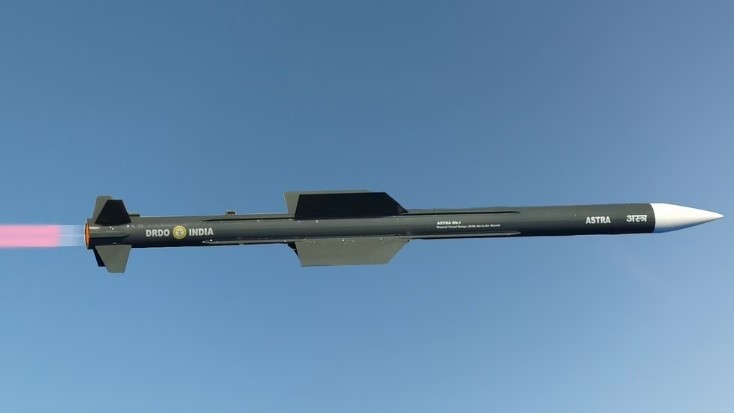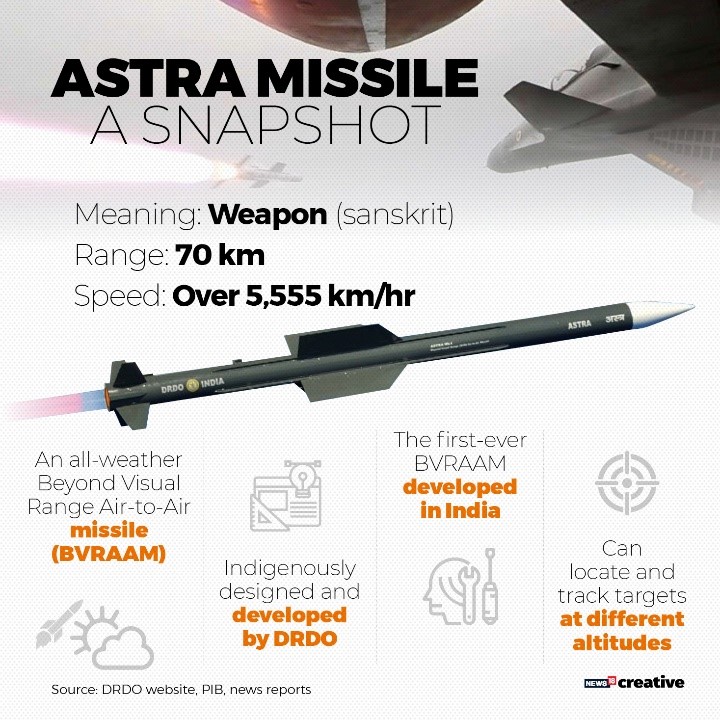Description

Disclaimer: Copyright infringement not intended.
Context
- Indigenously developed Light Combat Aircraft (LCA) Tejas successfully test-fired an indigenously developed ASTRA beyond visual range (BVR) air-to-air missile off the coast of Goa.
History
- The early 1990s marked the beginning of Astra rocket development. The French rocket Matra Super 530D was then used as a starting point.
- In 2004, the Indian Ministry of Defence started funding the development.
- Astra is 3.8 metres long and 175 millimetres wide (254 mm including wings).
- The entire mass of the rocket surpasses 150 kilogrammes.
- According to the Astra mk1s technical description, it can attack targets flying at speeds of up to Mach 1.4 at a distance of 110 kilometres.
- After launch, the Astra employs ‘Inertial Mid-Course Guidance’ through a secure data connection from its mother aircraft, followed by ‘Active Radar Homing’ from its seeker’s head for terminal guidance.
- DRDO had decided to equip the Astra missile’s terminal guidance with the Russian ‘Agat 9B1103M’ active radar seeker during the development phase.
- The Russian active radar seeker was used throughout the whole of Astra’s D&D, including firing testing, up to 2017.
- DRDO has developed a fully functional Ku-band active radar seeker for India. This indigenous, form-fitting seeker has been placed on all Astra missiles.
- Thus, India now has its first cutting-edge beyond-visual-range air-to-air missiles (BVR AAM) with an indigenous active radar seeker built indigenously.

Astra Missiles
- Thus, Astra is an Indian family of all-weather beyond-visual-range air-to-air missile, developed by the Defence Research and Development Organisation.
- Different missiles of this family are capable of engaging targets at varying distances of 500 m up to 340 km. Astra Mk-1 has been integrated with Indian Air Force's Sukhoi Su-30MKI.
Astra Mark 1
- Limited series production of Astra Mk-1 missiles began in 2017.
- The Astra Mark 1, has a maximum head-on launch range of 100 kilometres, a speed of 4.5 Mach, and launch clearance up to 20 kilometres in height (66,000 ft).
- The Astra may either be launched by the mother ship or in buddy mode.
- Extensive and rigorous trials have validated the Astra missile’s warhead capability, maximum launch ranges against head-on and maneuvering targets, long-range target engagement capability, clear missile separation at supersonic speeds, and launch under high ‘G’ forces, and multiple missile launches against multiple targets.
- The Astra-1 is meant to carry a 15-kilogram pre-fragmented high explosive warhead that is ignited by a radio proximity fuse.
- The missile’s Electronic Counter-Countermeasure (ECCM) capabilities allow for unrestricted operation in an Electronic Counter-Countermeasure (ECM) environment.
- Astra MK-1 already in Service is better than the Chinese PL-12 used by Pakistan and China.
Astra Mark 2
- Astra MK-2 is the new version of Astra MK-1 with better range and launched from an ejector. The Astra MK-2 has conventional dual-pulse rocket motor with improved grain quality and with solid fuel.
- It is longer in length as a result of which more quantity of fuel can be loaded resulting in better range. Thus Astra Mk2 missile easily exceeds the performance of the USA made AIM-120D AMRAAM & Chinese made PL-15. It has been tested to 180 km. What sets it apart is its striking affordability.
- Astra MK-2 shares most of the key features of its predecessor Astra MK-1 such as aerodynamics, design, smokeless propulsion, Ku band AESA seeker, etc,. so its development process has been very fast.
- Astra MK-2 is likely to be inducted into IAF service by end of 2023 or Q1 2024 max as every system from design, body, dual pulse rocket motor, actuators, various sensors, warhead, instruments and Ku band AESA seeker has been validated and tested.
- It will also come with improved high-angle off boresight capability, improved ECCM system, will sport a way datalink (first for Indian missile) & an AESA radar which will improve the first kill probability by a significant margin.
Now work will be started on Mk3 version with range of 500km.
READ ABOUT TEJAS PROGRAM: https://www.iasgyan.in/daily-current-affairs/light-combat-aircraft-lca-mk1
|
PRACTICE QUESTION
Q. Consider the following statements with reference to Astra Missile:
1. It has Electronic Counter-Countermeasure (ECCM) capabilities.
2. Astra is an Indian family of all-weather beyond-visual-range air-to-air missiles.
3. Astra Mk1s can attack targets flying at speeds of up to Mach 1.4 at a distance of 510 kilometers.
How many of the above are correctly matched?
A) Only 1
B) Only 2
C) All 3
D) None
Answer: B) Only 2
|

https://www.indiatoday.in/india/story/tejas-sucessfully-fires-astra-missile-2425513-2023-08-23











